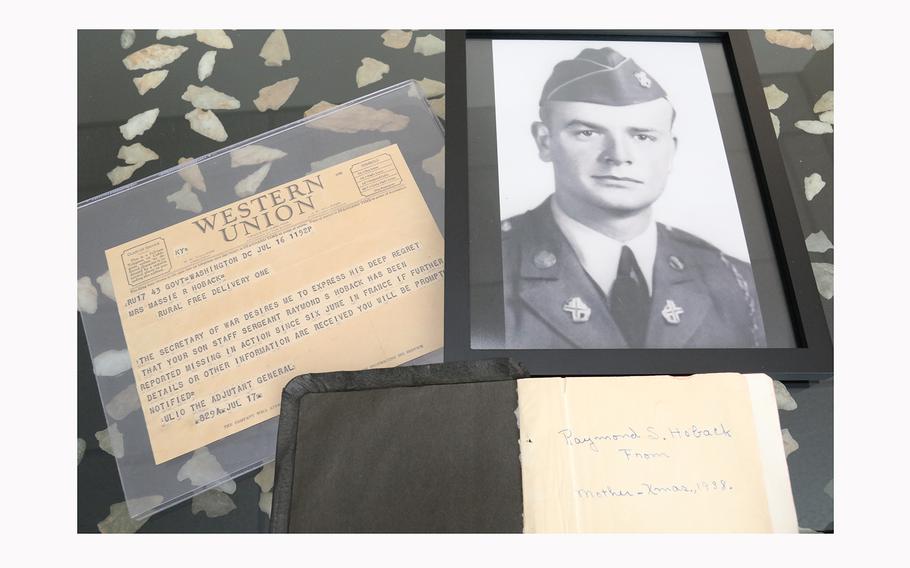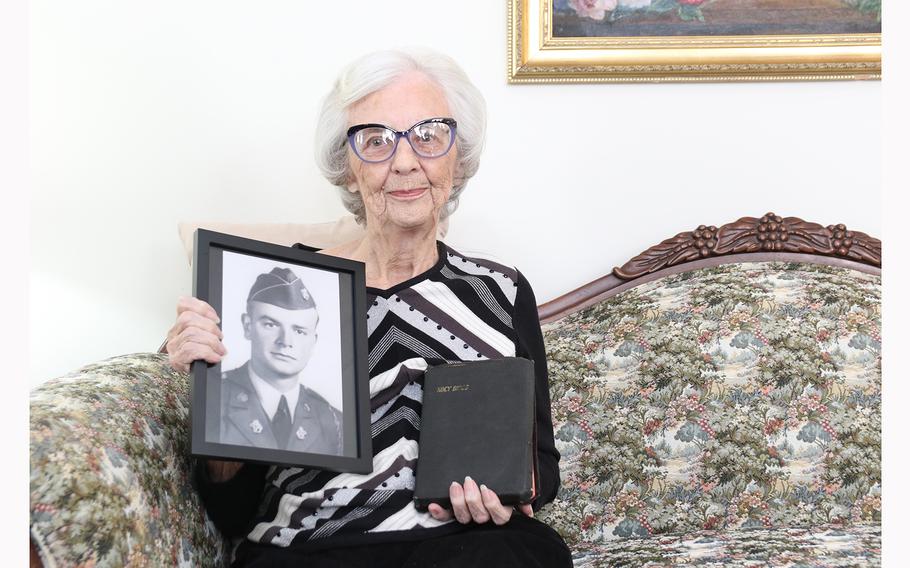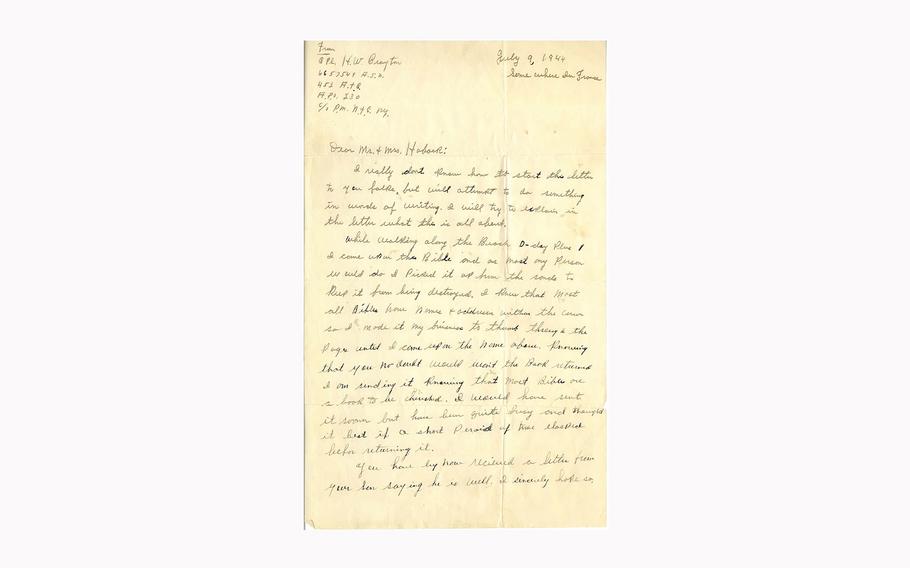
At left is the telegram notifying the Hoback family that Raymond Hoback was missing in action on D-Day. Top right is a photograph of Raymond Hoback. Below the photograph is his Bible, recovered by another soldier and sent home to his parents. (John Wilcher/National D-Day Memorial Foundation)
In the summer of 1944, Macie and John Hoback, who lived on a farm outside Bedford, Va., were in mourning.
Two of their sons, Raymond, 24, and Bedford, 30, had been killed during the D-Day invasion of France on June 6. Bedford’s body had been found. Raymond was missing in action and would later be declared dead.
The family was devastated, along with much of the small community in south-central Virginia. Eighteen other Bedford men also had been killed that day.
Several weeks later, the Hobacks got a package from a soldier they didn’t know. It contained Raymond’s Bible, which had been found on Omaha Beach, where he was killed. His mother had given it to him for Christmas in 1938.
This month, Raymond’s sister Lucille Hoback Boggess, 94, donated the Bible to the National D-Day Memorial in Bedford, giving the public a family treasure and a hallowed piece of the D-Day story.
“To know that they entrust this to us means so much,” said memorial president April Cheek-Messier. “For the family it was their tangible connection to Raymond for all those years, because they never recovered his body.”
“For us in the community, and for us as citizens of this country, really, this is a reminder of those sacrifices that were given that day, and what those families endured,” she said.
Bedford Hoback is buried at the Normandy American Cemetery and Memorial, not far from the beach.

Lucille Hoback Boggess holds a photograph of her brother Raymond Hoback and his bible. Bedford and Raymond Hoback, two brothers from Bedford, Va., were killed on Omaha Beach in the first wave on D-Day. (John Wilcher/National D-Day Memorial Foundation)
In a 2019 interview, Lucille Hoback Boggess said her mother felt that the two brothers had gone off to war together and should rest near each other.
The Bible is in excellent condition, perhaps because it was enclosed in an assault vest Raymond and other soldiers wore, said Art Beltrone, an appraiser from Keswick, Va., who has examined the Bible.
It is roughly five inches by eight inches and covered with black imitation leather on paper, John D. Long, the memorial’s director of education, said in an email.
The handover took place on November 13.
The Hoback brothers were among 2,500 Americans and 1,900 other allied service members who were killed on the beaches of Normandy during the invasion of Nazi-occupied France in World War II.
Twenty of the Americans came from the town and county of Bedford, about 170 miles southwest of Washington. “Bedford suffered the Nation’s highest known per capita D-Day loss,” the memorial says on its website.
“It was like a black veil dropped over the community,” Cheek-Messier, the memorial’s president, said an old veteran told her.
The community’s tragedy led to the building of the memorial, which opened in 2001, and a best-selling book, “The Bedford Boys,” by historian Alex Kershaw in 2003.
The Hobacks’ Bible has been a crucial part of the story. A sculpture at the memorial, “Death on Shore,” which depicts a fallen soldier on the beach with a Bible beside him, was inspired by the account.
On Sunday, July 16, 1944, the Hobacks, who had seven children, received a telegram as they were preparing for church. Bedford had been killed in action.
The next day they got a telegram saying that Raymond was missing.
“My mother just cried and cried,” their sister, Lucille Hoback Boggess, who was a teenager at the time, said in a 2019 interview. “Daddy went outside so people wouldn’t see him cry. Both of them were just devastated.”

A copy of the first page of the letter the Hobacks received from the soldier who found their son's Bible on the beach after D-Day and returned it. (National D-Day Memorial)
Several weeks later, the package with the Bible arrived with a letter from Army Cpl. Harold W. Crayton that was dated July 9. Crayton had found the Bible while walking on the beach the day after the attack.
He picked it up from the sand and saw that someone had written inside, “Mr. & Mrs. J.S. Hoback. Bedford Va.” On another page was written, “Raymond S. Hoback. From Mother. X-Mas. 1938.”
Crayton wrote: “Knowing that you no doubt would want the book returned, I am sending it, knowing that most Bibles are a book to be cherished.”
“You have by now received a letter from your son saying he is well,” Crayton wrote. “I sincerely hope so.”
“I imagine what has happened is that your son dropped the book without any notice,” he wrote. “Most everybody who landed on the beach . . . lost something.”
It is not clear exactly when the Hobacks received the Bible and the letter, which was also donated, the memorial said.
The Hobacks set up a shrine with the Bible, pictures of their sons, and their Purple Heart medals in the front parlor of their farmhouse, Lucille’s daughter, Macie Ann Boggess, said in a recent telephone interview.
“As grandchildren, we were never allowed in that room,” she said. “It was off-limits. . . . It was sacred territory.”
“Everything was very hush-hush,” she said. “You just didn’t talk about it. It was too painful. “
After she started volunteering at the memorial recently, she said, “three of the tour guides came up to me and said, ‘Please don’t let anything ever happen to that Bible. That’s the biggest story up here.’”
After her mother experienced some recent medical issues, she said she suggested that her mother donate the Bible while she still could.
“She thought this was a good time, that it finalized everything,” Macie Ann Boggess said. “She felt like it was good. She wanted to do it while she was able to do it.”
Next year will mark the 80th anniversary of D-Day, and “I just think this is perfect timing,” she said.
The Bible joins 15,000 other D-Day artifacts in the memorial’s collection, Cheek-Messier, the memorial’s president, said. For now, it will be displayed in the memorial’s education space.
But plans are to display it in a museum the memorial wants to build.
“It really has come full circle now,” she said. “We’ve told this story for so many years. We have this beautiful sculpture that illustrates it in a way. But now to have the actual Bible . . . will be so touching for people to see all of that come together.”